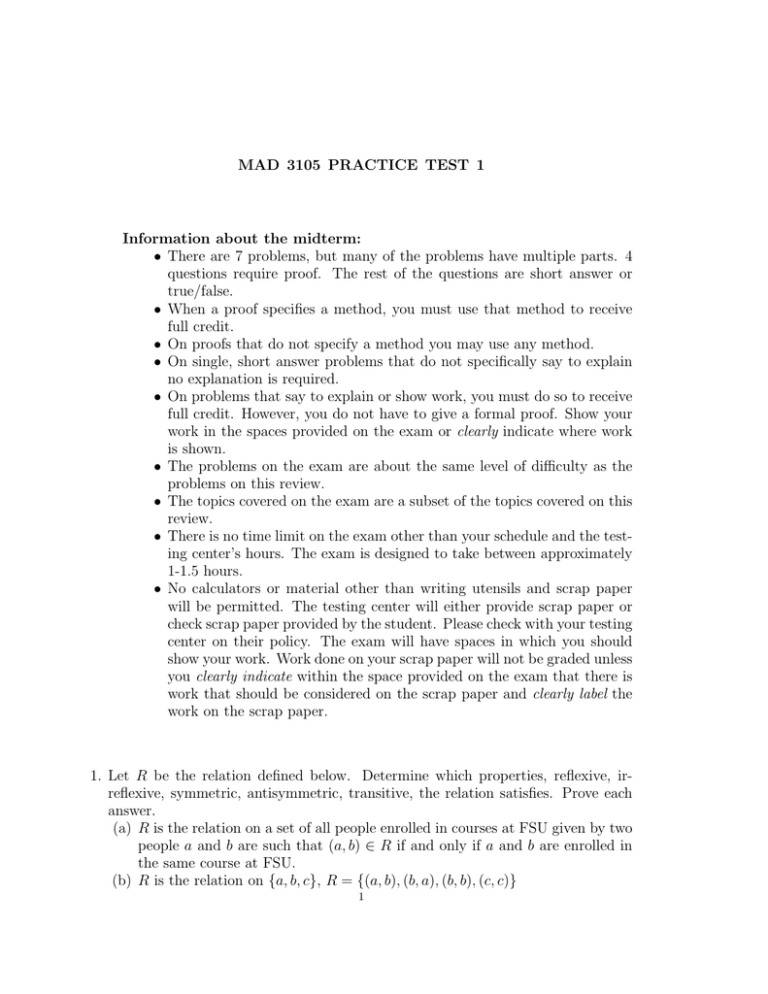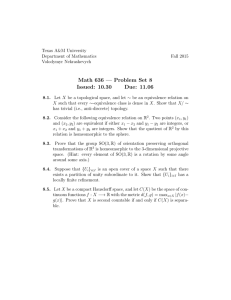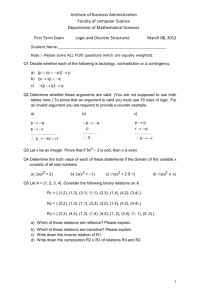MAD 3105 PRACTICE TEST 1 Information about the midterm:
advertisement

MAD 3105 PRACTICE TEST 1
Information about the midterm:
• There are 7 problems, but many of the problems have multiple parts. 4
questions require proof. The rest of the questions are short answer or
true/false.
• When a proof specifies a method, you must use that method to receive
full credit.
• On proofs that do not specify a method you may use any method.
• On single, short answer problems that do not specifically say to explain
no explanation is required.
• On problems that say to explain or show work, you must do so to receive
full credit. However, you do not have to give a formal proof. Show your
work in the spaces provided on the exam or clearly indicate where work
is shown.
• The problems on the exam are about the same level of difficulty as the
problems on this review.
• The topics covered on the exam are a subset of the topics covered on this
review.
• There is no time limit on the exam other than your schedule and the testing center’s hours. The exam is designed to take between approximately
1-1.5 hours.
• No calculators or material other than writing utensils and scrap paper
will be permitted. The testing center will either provide scrap paper or
check scrap paper provided by the student. Please check with your testing
center on their policy. The exam will have spaces in which you should
show your work. Work done on your scrap paper will not be graded unless
you clearly indicate within the space provided on the exam that there is
work that should be considered on the scrap paper and clearly label the
work on the scrap paper.
1. Let R be the relation defined below. Determine which properties, reflexive, irreflexive, symmetric, antisymmetric, transitive, the relation satisfies. Prove each
answer.
(a) R is the relation on a set of all people enrolled in courses at FSU given by two
people a and b are such that (a, b) ∈ R if and only if a and b are enrolled in
the same course at FSU.
(b) R is the relation on {a, b, c}, R = {(a, b), (b, a), (b, b), (c, c)}
1
MAD 3105 PRACTICE TEST 1
2
(c) R is the relation on the set of positive integers given by mRn if and only if
gcd(m, n) > 1.
(d) R is the relation on the set of positive real numbers given by xRy if and only
if x/y is a rational number.
(e) Let f : R → R be the function f (x) = bxc. Define the relation R on the set
of real numbers by R = graph(f ).
(f) Let f : R → R be the function f (x) = bxc. Define the relation R on the set
of real numbers by aRb iff f (a) = f (b).
2. Let R be the relation R = {(a, c), (b, b), (b, c), (c, a)} and S the relation S =
{(a, a), (a, b), (b, c), (c, a)} is a relation on A = {a, b, c}.
(a) Find R2 .
(b) Find S ◦ R.
(c) Find R−1
3. The matrix below is the matrix for a relation.
0
0
1
0
1
1
0
1
0
1
1
1
0
0
1
0
(a) Which of the following properties does the relation satisfy: reflexive, irreflexive, symmetric, antisymmetric, asymmetric, transitive?
(b) Find the matrix that represents R−1 .
(c) Find the matrix that represents R2 .
(d) Find the matrix that represents r(R).
(e) Find the matrix that represents s(R).
(f) Find the matrix that represents t(R).
4. Let A be a set and let R and S be relations on A. If R and S satisfy the property
given, does the relation given have to satisfy the same property? Prove or disprove
each answer.
(a) Reflexive, R ∪ S
(b) Reflexive, R−1
(c) Symmetric, t(R)
(d) Symmetric, R ◦ S
(e) Antisymmetric, R ⊕ S
(f) Antisymmetric, Rn for any positive integer n
(g) Transitive, r(R)
(h) Transitive, R−1
(i) Equivalence Relation, R − S
(j) Equivalence Relation, Rn for any positive integer n
(k) Partial Order, R ◦ S
(l) Partial Order, R ⊕ S
5. Let R1 be a relation from S to T and let R2 be a relation from T to U . Prove
(R2 ◦ R1 )−1 = R1−1 ◦ R2−1 .
MAD 3105 PRACTICE TEST 1
3
6. Let A = {1, 2, 3, 4, 5} and let R1 be the relation give by (n, m) ∈ R1 iff n ≡
m(mod 3).
(a) Give the Boolean matrix for the relation.
(b) Draw the digraph for the relation.
7. True or false, prove or disprove: If R and S are relations on A, then
(a) r(R ∩ S) = r(R) ∩ r(S).
(b) r(R − S) = r(R) − r(S).
(c) s(R ∪ S) = s(R) ∪ s(S).
(d) s(R ◦ S) = s(R) ◦ s(S).
(e) t(R ∪ S) = t(R) ∪ t(S).
(f) t(R ◦ S) = t(R) ◦ t(S).
8. Let R be the relation on the set of all integers given by nRm if and only if nm < 0.
(a) Describe the reflexive closure of R. Begin with the expression “(m, n) ∈ r(R)
if and only if . . . .”
(b) Describe the symmetric closure of R
(c) Describe the transitive closure of R
9. Which of the following relations are equivalence relations. For the relations that
are equivalence relations find the equivalence classes. For the ones that are not
equivalence relations name the property(ies) that fails.
(a) The relation R on the set of Computer Science majors at FSU where aRb iff
a and b are currently enrolled in the same course.
(b) The relation R on the set of integers where (m, n) ∈ R if and only if mn ≡
2(mod 2).
(c) The relation R on the set of ordered pairs of integers where (a, b)R(c, d) iff
a = c or b = d
(d) Let f : R → R be the function defined by f (x) = dxe. Define the relation R
on R by (x, y) ∈ R if and only if f (x) = f (y).
(e) The relation R on the set of all subsets of {1, 2, 3, 4} where SRT means S ⊆ T
(f) The relation R on the set of positive integers where (m, n) ∈ R if and only if
gcd(m, n) = max{m, n}.
(g) Let G = (V, E) be a simple graph. Let R be the relation on V consisting of
pairs of vertices (u, v) such that there is a path from u to v or such that u = v.
(h) The relation R on the set of ordered pairs Z+ × Z+ of positive integers defined
by
(a, b)R(c, d) ⇔ a + d = b + c.
10. Let R be the relation on the set of ordered pairs of positive integers such that
(a, b)R(c, d) if and only if ad = bc.
(a) Prove R is an equivalence relation.
(b) Find the equivalence class of (a, b) where (a, b) ∈ Z+ × Z+ :
11. Let R be the relation on the set R real numbers defined by xRy iff x − y is an
integer. Prove that R is an equivalence relation on R.
12. Suppose A = {2, 4, 5, 6, 7, 10, 18, 20, 24, 25} and R is the partial order relation
(x, y) ∈ R iff x|y.
MAD 3105 PRACTICE TEST 1
4
(a) Draw the Hasse diagram for the relation.
(b) Find all minimal elements.
(c) Find all maximal elements.
(d) Find all upper bounds for {6}.
(e) Find all lower bounds for {6}.
(f) Find the least upper bound for {6}.
(g) Find the greatest lower bound for {6}.
(h) Find the least element.
(i) Find the greatest element.
(j) Is this a lattice?
13. Suppose A = {2, 3, 4, 5} has the usual “less than or equal” order on integers. Find
each of the following for the case where R is the lexicographic order relation on
A × A and where R is the product order relation on A × A.
(a) Draw the Hasse diagram for the relation.
(b) Find all minimal elements.
(c) Find all maximal elements.
(d) Find all upper bounds for {(2, 3), (3, 2)}.
(e) Find all lower bounds for {(2, 3), (3, 2)}.
(f) Find the least upper bound for {(2, 3), (3, 2)}.
(g) Find the greatest lower bound for {(2, 3), (3, 2)}.
(h) Find the least element.
(i) Find the greatest element.
(j) Is this a lattice?
14. Carefully prove the following relations are partial orders.
(a) Recall the product order: Let (A1 , 1 ) and (A2 , 2 ) be posets. Define the
relation on A1 × A2 by (a1 , a2 ) (b1 , b2 ) if and only if a1 1 b1 and
a2 2 b2 . Prove the product order is a partial order.
(b) Let (B, B ) be a poset and let A be a set. Define the set F U N (A, B) to be
the set of all functions with domain A and codomain B. Prove the relation F
on F U N (A, B) defined by f F g iff f (t) B g(t) ∀t ∈ B is a partial order.
(c) Let (A, A ) and (B, B ) be posets and recall the lexicographic order, L on
A × B is defined by
(a, b) L (c, d) ⇔ [(a A c) ∧ ((a = c) → (b B d))].
Prove the lexicographic order on A × B is a partial order.
15. Suppose R is a relation on A. Using the property that composition is associative
and mathematical induction, prove that Rn ◦ R = R ◦ Rn .
16. Prove that a relation R on a set A is transitive if and only if Rn ⊆ R for all positive
integers n.
17. Suppose (A, ) is a poset such that every nonempty subset of A has a least element.
Prove that is a total ordering on A.
18. Prove: Suppose (A, ) is a finite nonempty poset. Then A has a minimal element.




